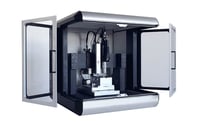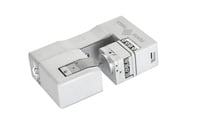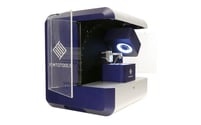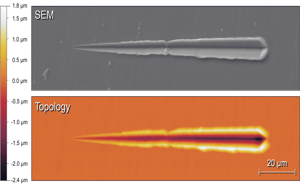
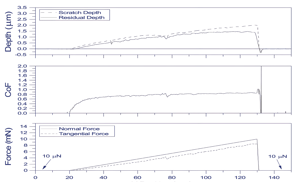
Scratch testing is one of the oldest methods for assessing hardness and is also among the least well-understood. This is primarily due to the complexity of the stress states at the tip. However, perhaps all that is needed is a more comprehensive view.
With the use of new nanoindentation tools, it is now possible to clearly visualize deformation processes during scratch testing, while simultaneously measuring depth, normal and lateral forces, coefficients of friction, and acquiring pre- and post-scans of surface topology. This advancement brings scratch testing firmly into the toolkit of the modern materials scientist.
Application Examples
- 01 Tribological Assessment
- 02 Friction Analysis
- 03 Scratch of Coatings
Tribology and Chip Formation
Scratch testing plays a crucial role in understanding wear mechanisms in tribology, specifically abrasion and erosion processes, as well as offering insight into chip formation during machining. Through observation of various materials deformation behaviors (e.g. plastic slip, grain rotation and pile-up, shear banding, extrusion, and cracking), we gain valuable technical knowledge.
In this application example, an aluminum single crystal (SX) demonstrates smooth deformation, highlighting the importance of slip planes, while ultra-fine grained (UFG) aluminum exhibits a textured chip, indicating the movement of individual grains. Additionally, bulk metallic glass (BMG) and Al-Cu eutectic alloy samples display unique deformation patterns, like serrated flow and local scratch hardness variation, respectively.
| 0.5 nN Force resolution |
100 kN/m Sensing element stiffness |
Effects of Material Imperfections on Cutting Resistance and Surface Friction
Nothing is perfect, especially in engineering materials, where 'imperfections' like grain boundaries can enhance an alloy's strength.
In situ videos and scratch data illustrate how the Cube Corner diamond tip interacts with defects and inclusions in samples, affecting chip formation and causing machining chatter.
The aluminum 5052 marine alloy’s inclusion reduces penetration depth and increases friction significantly, while the bulk metallic glass (BMG) shows lower scratch resistance, evidenced by serrated flow due to shear banding under higher loads
| 0.5 nN Force resolution |
100 kN/m Sensing element stiffness |
Overcoming Industrial Scaling Challenges for MoS2 Solid Lubricant Coatings
Molybdenum disulfide (MoS2) is a popular solid lubricant coating used in various industries, particularly in applications where traditional liquid lubricants may not be suitable. They are commonly used for providing dry lubrication in bearings under challenging environmental conditions, e.g., vacuum, high load, and irradiation.
However, industrial upscaling frequently results in a different coating microstructure than the laboratory prototypes presented in the literature.
Therefore, to ensure full functionality in these coating systems, the coatings must be cohesive and well-adhered to their substrate, whether that is another coating, a silicon wafer, or precision optics.
| 0.5 nN Force resolution |
100 kN/m Sensing element stiffness |
Application Notes
Nano-Scratch Testing of Thin Films
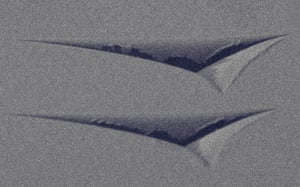
Nanoindentation
READ MORE ->
Read More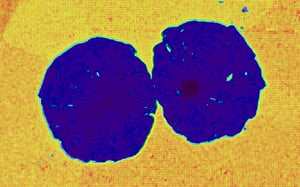
Mechanical Microscopy
READ MORE ->
Read More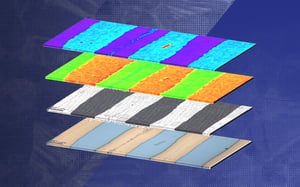
Correlative Mechanical Microscopy
READ MORE ->
Read More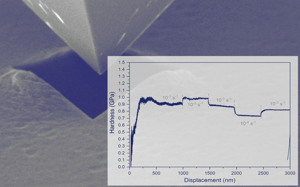
Strain-Rate Control
READ MORE ->
Read More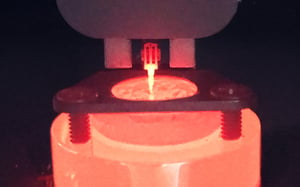
High-Temperature Testing
READ MORE ->
Read More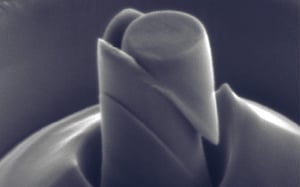
Micro-Pillar Compression
READ MORE ->
Read More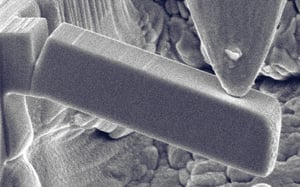
Micro-Cantilever Testing
READ MORE ->
Read More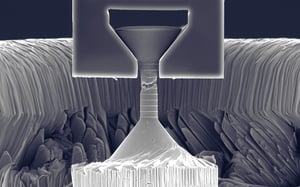
Micro-Tensile Testing
READ MORE ->
Read More
